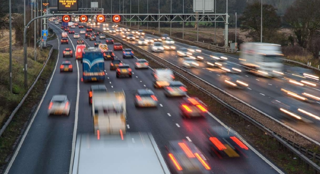London is the third most expensive city in the world to drive in both a petrol and a diesel car, new data published today (Wednesday, January 10) suggests.
Furthermore, eight other UK cities appeared in the ‘top 50’ list of the most expensive cities in the world for diesel cars in 2023, up from five the previous year.
The data, which shows the impact of congestion on the cost of driving, has been published as part of TomTom’s annual TomTom Traffic Index, a report detailing traffic trends seen in 387 cities across 55 countries throughout 2023.
This year, TomTom has again assessed the cost of driving in terms of time, money and environmental impact for every mile driven.
Data relating to average travel times, detailing the country’s most congested cities, shows London remained the slowest city in the world to drive through, and the third most expensive.
Stephanie Leonard, head of government and regulatory affairs at TomTom, said: “Despite petrol prices falling, our analysis of the economic impact of congestion showed that London’s slow-moving traffic and higher fuel consumption made it one of the most expensive cities in the world for driving.”
TomTom estimates that avoiding peak hours could save drivers up to £187 per year on fuel costs.
Ranking: UK cities with highest cost of driving at rush hours
|
City |
Petrol car |
Diesel car |
||
|
|
Yearly fuel cost |
Due to congestion |
Yearly fuel cost |
Due to congestion |
|
London |
£734 |
£187 |
£649 |
£158 |
|
Swansea |
£525 |
£116 |
£549 |
£117 |
|
Brighton and Hove |
£566 |
£102 |
£549 |
£82 |
|
Sheffield |
£524 |
£102 |
£541 |
£87 |
|
Edinburgh |
£533 |
£90 |
£518 |
£74 |
|
Bristol |
£536 |
£115 |
£530 |
£100 |
|
Glasgow |
£505 |
£91 |
£504 |
£77 |
|
Manchester |
£545 |
£122 |
£520 |
£106 |
|
Birmingham |
£517 |
£109 |
£513 |
£92 |
|
Leicester |
£576 |
£109 |
£509 |
£86 |
Average annual fuel cost spent for a home-to-work distance of six miles driven at morning and evening peak hours (total 12 miles/day), in minutes/seconds. Source: TomTom.
Impact of congestion on CO2 emissions

Leonard explains that low emission zones (LEZs) across Europe have proven to make a long-term difference to the levels of pollutants and greenhouse gases in urban environments.
“Above all, they ensure that drivers of polluting vehicles are disincentivised from driving into city centres by levying heavy charges,” she said.
“However, the best thing to hope for is the UK’s LEZs become irrelevant as the volume of electric vehicles (EVs) increases in line with other regulations that ban the sale of combustion engine vehicles.”
When EVs do become the norm, better traffic management will be needed to ensure viable traffic flows and the efficient use of city infrastructure, particularly in cities with antiquated road networks like London, argues Leonard.
“Real-time data intelligence will play a significant role here in transforming how people move around UK cities, supporting our transition to less diesel and petrol consumption and more sustainable transportation,” she added.
Ranking: Cities with the highest CO2 emissions per car at rush hour
|
City centre (3-mi radius) |
Petrol car |
Diesel car |
||
|
|
Yearly fuel cost |
Due to congestion |
Yearly fuel cost |
Due to congestion |
|
London |
1116 kg |
285 kg |
1048 kg |
255 kg |
|
Manchester |
890 kg |
199 kg |
851 kg |
173 kg |
|
Bristol |
886 kg |
189 kg |
873 kg |
165 kg |
|
Brighton-and-hove |
880 kg |
159 kg |
878 kg |
131 kg |
|
Sheffield |
874 kg |
171 kg |
878 kg |
141 kg |
|
Swansea |
874 kg |
193 kg |
910 kg |
194 kg |
|
Edinburgh |
863 kg |
146 kg |
845 kg |
120 kg |
|
Birmingham |
847 kg |
179 kg |
835 kg |
150 kg |
|
Liverpool |
841 kg |
138 kg |
815 kg |
112 kg |
|
Leicester |
839 kg |
159 kg |
823 kg |
140 kg |
Average annual CO2 emissions based on a home-to-work distance of six miles driven at morning and evening peak hours (total 20 km/day), in kg of CO2. Source: TomTom.
For more findings from the annual TomTom Traffic Index, including average travel times in the country’s most congested cities, click here.






















Login to comment
Comments
No comments have been made yet.